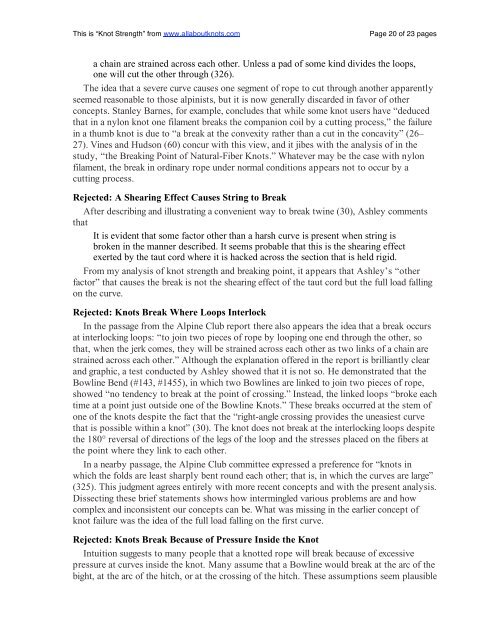Create successful ePaper yourself
Turn your PDF publications into a flip-book with our unique Google optimized e-Paper software.
This is “<strong>Knot</strong> <strong>Strength</strong>” from www.allaboutknots.com<br />
<strong>Page</strong> 20 of 23 pages<br />
a chain are strained across each other. Unless a pad of some kind divides the loops,<br />
one will cut the other through (326).<br />
The idea that a severe curve causes one segment of rope to cut through another apparently<br />
seemed reasonable to those alpinists, but it is now generally discarded in favor of other<br />
concepts. Stanley Barnes, for example, concludes that while some knot users have “deduced<br />
that in a nylon knot one filament breaks the companion coil by a cutting process,” the failure<br />
in a thumb knot is due to “a break at the convexity rather than a cut in the concavity” (26–<br />
27). Vines <strong>and</strong> Hudson (60) concur with this view, <strong>and</strong> it jibes with the analysis of in the<br />
study, “the Breaking Point of Natural-Fiber <strong>Knot</strong>s.” Whatever may be the case with nylon<br />
filament, the break in ordinary rope under normal conditions appears not to occur by a<br />
cutting process.<br />
Rejected: A Shearing Effect Causes String to Break<br />
After describing <strong>and</strong> illustrating a convenient way to break twine (30), Ashley comments<br />
that<br />
It is evident that some factor other than a harsh curve is present when string is<br />
broken in the manner described. It seems probable that this is the shearing effect<br />
exerted by the taut cord where it is hacked across the section that is held rigid.<br />
From my analysis of knot strength <strong>and</strong> breaking point, it appears that Ashley’s “other<br />
factor” that causes the break is not the shearing effect of the taut cord but the full load falling<br />
on the curve.<br />
Rejected: <strong>Knot</strong>s Break Where Loops Interlock<br />
In the passage from the Alpine Club report there also appears the idea that a break occurs<br />
at interlocking loops: “to join two pieces of rope by looping one end through the other, so<br />
that, when the jerk comes, they will be strained across each other as two links of a chain are<br />
strained across each other.” Although the explanation offered in the report is brilliantly clear<br />
<strong>and</strong> graphic, a test conducted by Ashley showed that it is not so. He demonstrated that the<br />
Bowline Bend (#143, #1455), in which two Bowlines are linked to join two pieces of rope,<br />
showed “no tendency to break at the point of crossing.” Instead, the linked loops “broke each<br />
time at a point just outside one of the Bowline <strong>Knot</strong>s.” These breaks occurred at the stem of<br />
one of the knots despite the fact that the “right-angle crossing provides the uneasiest curve<br />
that is possible within a knot” (30). The knot does not break at the interlocking loops despite<br />
the 180° reversal of directions of the legs of the loop <strong>and</strong> the stresses placed on the fibers at<br />
the point where they link to each other.<br />
In a nearby passage, the Alpine Club committee expressed a preference for “knots in<br />
which the folds are least sharply bent round each other; that is, in which the curves are large”<br />
(325). This judgment agrees entirely with more recent concepts <strong>and</strong> with the present analysis.<br />
Dissecting these brief statements shows how intermingled various problems are <strong>and</strong> how<br />
complex <strong>and</strong> inconsistent our concepts can be. What was missing in the earlier concept of<br />
knot failure was the idea of the full load falling on the first curve.<br />
Rejected: <strong>Knot</strong>s Break Because of Pressure Inside the <strong>Knot</strong><br />
Intuition suggests to many people that a knotted rope will break because of excessive<br />
pressure at curves inside the knot. Many assume that a Bowline would break at the arc of the<br />
bight, at the arc of the hitch, or at the crossing of the hitch. These assumptions seem plausible

















